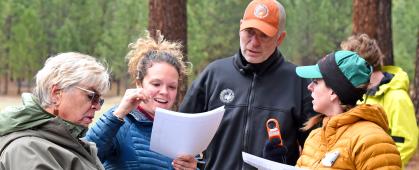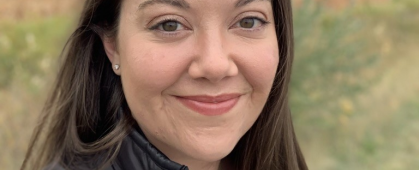Pre-service teachers (future science teachers) from EDM 403 and EDM 415 (Science Methods) at MSU helped pilot-test Temtop air quality instruments as part of their classes’ unit on citizen science. The instruments will become part of the SMART FIRES Instrument Lending Library being developed for Montana teachers.
The students first learned general concepts about citizen science: that regular people can contribute to scientific discovery by collecting data and sharing observations. They then took part in the popular Tomatosphere project developed by First the Seed Foundation to help scientists understand issues related to long-term space travel. In this project, the classroom receives two packets of tomato seeds. One packet has traveled in space; the other has not. Students plant seeds from each packet, watch them germinate and grow, send observations back to the project organizers and theorize on how the “space seeds” may differ from the other packet. Project organizers then reveal which set of seeds has been to space. 3 million students across the United States and Canada have taken part in the project since its inception in 2001.
On day 2, the future teachers used iNaturalist and Seek to identify trees, flowers, insects and lichen and took a clouds observation with GLOBE Observer. They learned about PM 10 and PM 2.5 and used the Temtop devices to measure air quality at various locations (PM stands for particulate matter. The PM 10 measurement indicates particles of 10 microns or less – typically items like dust or pollen. PM 2.5 particulates – those smaller than 2.5 microns – can come from pollution or vehicle exhaust and are more dangerous, as they can lodge in the lungs). The students took measurements near water, grass, concrete, a busy roadway, a construction site and a vent from a building. The instruments were prepared for the class by new SMART FIRES graduate student Elizabeth Chura.
After using the Temtops, the pre-service teachers gave feedback on how the data collection instruments and citizen science could be used with elementary, middle or high school students.
They noted, in general, that citizen science would work well in the classroom, especially for extra credit, an end-of-year project, or during flexible time when students have finished their regular work.
The MSU students also recognized that citizen science could fulfill the Engagement stage of the 7 E’s (a science teaching and learning cycle) and could also help young people build their STEM identities by acting as scientists. The MSU students also noticed the opportunity to discuss respect for nature, such as observing but not harming bugs or plants.
The pre-service teachers appreciated the data gathering and graphing functions of the Temtops, saying it would be valuable for all grades from third on up. They theorized that for younger students, use of a device like a Temtop could be the conclusion of an overall lesson about scientific instruments.
For activities using the Temtop, the future educators suggested asking students to predict which areas near their school would have the highest PM 2.5 and PM 10 measurements; take photos of sites to combine with numerical air quality data; and learn mapping skills by trying to match actual air quality measurements to specific locations.
The lessons and loan of the instruments was made possible by the Montana Citizen Science Network, a program that was launched by Montana NSF EPSCoR.

